This weekend I’m playing in the Winter Open at the Bay Area Chess Center. This is the first time I have been to their new headquarters (the bigger tournaments are usually at hotels). It’s a pretty nice place, except for the fact that there is only one bathroom. They were able to fit in 76 players this weekend without having it feel too crowded.
There’s very little to say about my games. I’ve played three games and haven’t lost any… but I also haven’t won any. Three straight draws are enough to try anyone’s patience. At least the first two were pretty good games. The third was a toxic dump of a game where I got a passive position and just sat. My opponent wasn’t willing to take any risks, so he just sat, too, and we eventually repeated moves on move 29, with all the pieces (except one pair of knights and one pair of pawns) still on the board!
Fortunately, I have other games to write about. Linnea came to this tournament with me, and we had very high hopes for her. She is playing in the under-1500 section. At 1273 she is way underrated, and they have an under-1300 prize that is perfect for her. Well, in round one she had a superior position against a 1000 player and then walked into a mate-in-one. That was the first time I’ve ever seen her upset after a game.
But I talked her off the ledge (just joking!) and today she had the kind of performance I knew she could. She won all three games, and with a score of 3-1 she has a great shot at the under-1300 prize and even a decent chance at winning the whole section. (Note: The under-1500 section is playing six rounds, while the open section is playing five rounds.)
While I was waiting for Linnea’s game to finish I watched an interesting game in the open section, on the board right next to where I had been playing. It was between two young players named Michael Wang (White) and Pranav Nagarajan (Black).
FEN: 8/8/R7/p1p3p1/1p1bK1k1/1P6/P7/8 b – – 0 1
Already in this position something unusual happened. Black claimed a draw by threefold repetition. The TD was summoned and he played over the scoresheet. It turned out that the position had occurred three times but the first time was with White to move, while the second and third times were with Black to move! So the draw claim was denied. Of course I knew about the same-player-to-move clause, but I’ve never seen it invoked before.
I should mention another thing, which is the time situation. White had 3 minutes left on his clock, while Black had an hour and 5 minutes. We were playing a FIDE time control, with a 30 second time increment added every move. So White was able to “live on the increment,” but even so I truly admire his courage in continuing to play this position rather than giving it up as drawn.
After 1. … Kh3 2. Kf5 Be3 3. Rd6 Kg2?! 4. Ke4 Kf2 5. Rd3 Bf4 6. Kf5 Ke2 7. Rd5 Be3 8. Kg4 Kf2 9. Re5 Ke2 10. Kg3 Kd3 (Black actually tried to play 10. … Bf4+ but the bishop is pinned!) 11. Kf3 we reached the following position:
For the first time I started to think White might win. Black is forced to abandon one of his two pawns. Which one should he give up?
(space added so you can think about it)
11. … Bd4!
Correct! First, on general principle Black would like to shorten the board. Also, if he gives up the c-pawn the a-pawn will soon follow. And finally, Black has already seen that he is going to win the pawn back!
12. Rxg5 Kc2 13. Ke4 Kb1 14. Rg2 Bb2
White cannot defend the a-pawn. Now in this back-and-forth endgame you might think that Black will draw. But there is more to come …
15. Kd3 Kxa2 16. Kc4 Ka3 17. Rf2 …
I was a little puzzled by this move but it turns out that the very young player of the White pieces (maybe ten years old?) knows exactly what he is doing. He is trying to tempt Black into playing 17. … a4? 18. ba! when Black can’t take back because his bishop would fall. And if 18. … Bd4 19. Rf7 he still can’t take because of checkmate threats.
The moral is, give your opponent every possible chance to go wrong — even if you have only 3 minutes on your clock and he has an hour.
17. … Bc3 18. Rf7 Bd4 19. Ra7 …
And now it’s Black who has to lose a pawn. Does that mean White is winning now? I’m not telling!
19. … Kb2 20. Rxa5 Kc2 21. Ra2+ Bb2!
If White had any ways to lose a tempo he would be winning the game, but there are none. He has to move his rook away.
22. Ra6 Bd4 23. Rh6 Kb2 24. Rh2+ Ka3!
I was quite impressed with this move by Nagarajan. It looks as if he could be walking into a mating net. But White has no pieces other than the rook to check the king with, and as soon as the rook moves away from the 2nd rank, the king escapes. Meanwhile, Black realizes that the key thing is for his king to remain in contact with the b-pawn. As long as that’s the case, White can never play Kxc5.
At this point Black was playing very confidently and I was sure that he would draw.
25. Re2 Bc3 26. Re7 Kb2 27. Rh7 Bd4 28. Rc7 Kc2 29. Ra7 Kb2 30. Ra5 …
White has made absolutely no progress since the last diagram. I don’t even know what he was playing for at this point. Did he intend to play 40 more moves until Black could claim a draw by the 50-move rule?
Whatever the reason, his prayers were now answered. After finally reaching a clearly drawn position, Black now throws it all away with
30. … Bc3??
He just forgot that his c-pawn is under attack from the rook as well as the king.
31. Rxc5 and White won after a few more moves.
What a tragic ending for Black! But there are two good lessons to be learned here. First, Black was clearly rushing his moves in order to keep White under time pressure. I mentioned earlier that Black had 1:05 on his clock to White’s 3 minutes. When this blunder occurred, Black still had 1:01 on his clock to White’s one minute. In other words, Black has been playing just as fast as White! And this move was played very hastily; I think he took less than 10 seconds on it.
Lesson 1: Never try to “blitz” your opponent when he is in time pressure and you’re not.
The second lesson is one I already mentioned, but it bears repeating.
Lesson 2: When you have the advantage in the endgame, take your time and give your opponent every possible chance to go wrong. Even when the spectators think you should agree to a draw and go home!
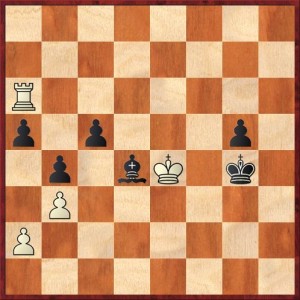

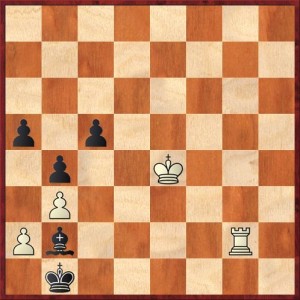
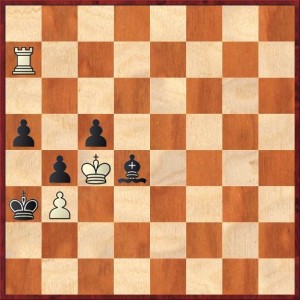
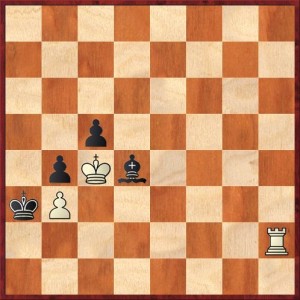
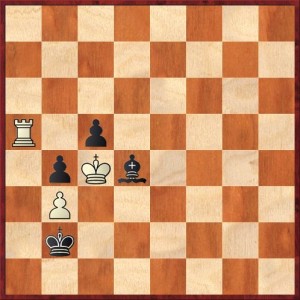



{ 4 comments… read them below or add one }
Nice ending. I think in general, it’s pointless playing endgames with no time (but alas, it’s a competitive sport). But even so, this was not a fun endgame to be playing as black anyway. All the pawns were on dark squares- a good thing here, as they were covered by the B- and blockaded. Even after winning the a pawn, black had no winning chances (yes, I suppose this was objectively drawn).
Good luck in the tourney!
By the way, I think black was Pranav.
A couple corrections I found to your notation as I played along: 2.Kf5, 9.Re5. (Feel free to delete this comment afterwards.)
Praveen and Dan, Thanks for finding my typos. I made the corrections.